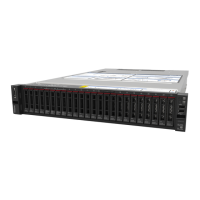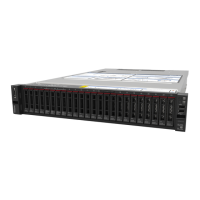Notes: The Lenovo XClarity Provisioning Manager provides a Graphical User Interface to configure a
server. The text-based interface to system configuration (the Setup Utility) is also available. From Lenovo
XClarity Provisioning Manager, you can choose to restart the server and access the text-based interface.
In addition, you can choose to make the text-based interface the default interface that is displayed when
you start LXPM. To do this, go to Lenovo XClarity Provisioning Manager ➙ UEFI Setup ➙ System
Settings ➙ <F1>Start Control ➙ Text Setup. To start the server with Graphic User Interface, select Auto
or Tool Suite.
See the following documentations for more information:
– Search for the LXPM documentation version compatible with your server at
https://pubs.lenovo.com/
lxpm-overview/
– UEFI User Guide at https://pubs.lenovo.com/uefi-overview/
• Lenovo XClarity Essentials OneCLI
You can use the config application and commands to view the current system configuration settings and
make changes to Lenovo XClarity Controller and UEFI. The saved configuration information can be used
to replicate or restore other systems.
For information about configuring the server using Lenovo XClarity Essentials OneCLI, see:
https://pubs.lenovo.com/lxce-onecli/onecli_c_settings_info_commands
• Lenovo XClarity Controller
You can configure the management processor for the server through the Lenovo XClarity Controller Web
interface, the command-line interface, or Redfish API.
For information about configuring the server using Lenovo XClarity Controller, see:
“Configuring the Server” section in the XCC documentation compatible with your server at
https://
pubs.lenovo.com/lxcc-overview/
Enable Software Guard Extensions (SGX)
Intel
®
Software Guard Extensions (Intel
®
SGX) operates under the assumption that the security perimeter
includes only the internals of the CPU package, and leaves the DRAM untrusted.
Complete the following steps to enable SGX.
Step 1. Make sure to refer to
“Memory module installation rules and order” on page 62, which specifies
whether your sever supports SGX and lists the memory module population sequence for SGX
configuration. (DIMM configuration must be at least 8 DIMMs per socket to support SGX.)
Step 2. Restart the system. Before the operating system starts up, press the key specified in the on-screen
instructions to enter the Setup Utility. (For more information, see the “Startup” section in the LXPM
documentation compatible with your server at
https://pubs.lenovo.com/lxpm-overview/.)
Step 3. Go to System settings ➙ Processors ➙ Total Memory Encryption and enable the option.
Step 4. Save the changes, then go to System settings ➙ Processors ➙ SW Guard Extension and enable
the option.
RAID configuration
Using a Redundant Array of Independent Disks (RAID) to store data remains one of the most common and
cost-efficient methods to increase server's storage performance, availability, and capacity.
294
ThinkSystem SR630 V4 User Guide

